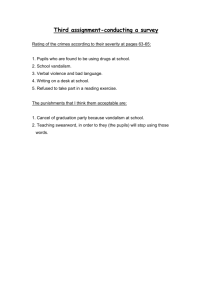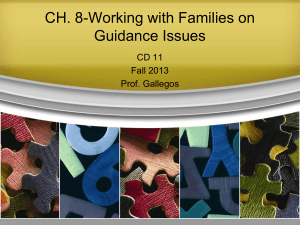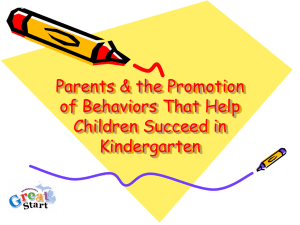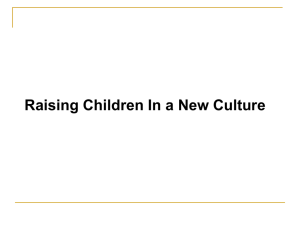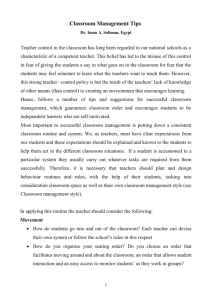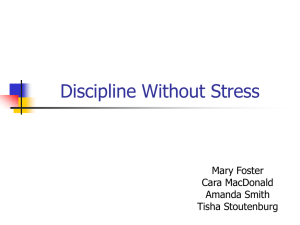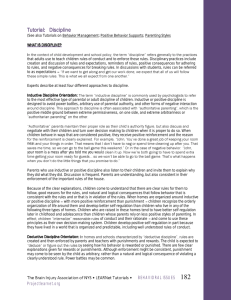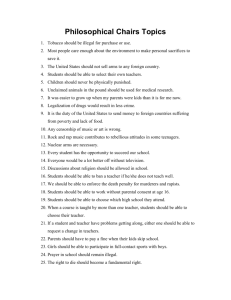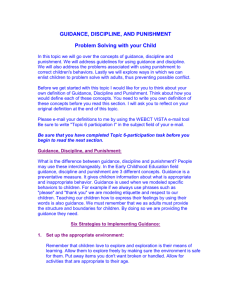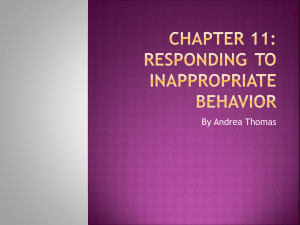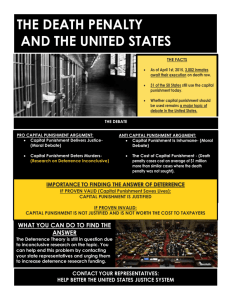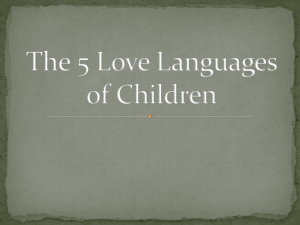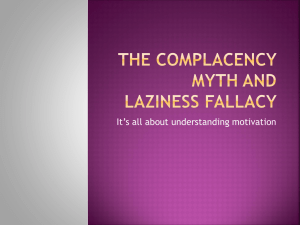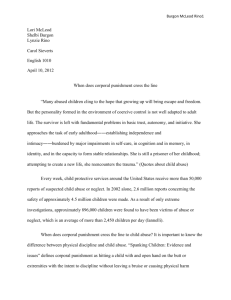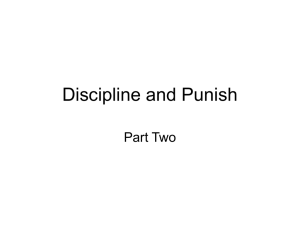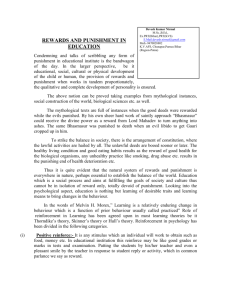Marvin Marshall Presentation
advertisement
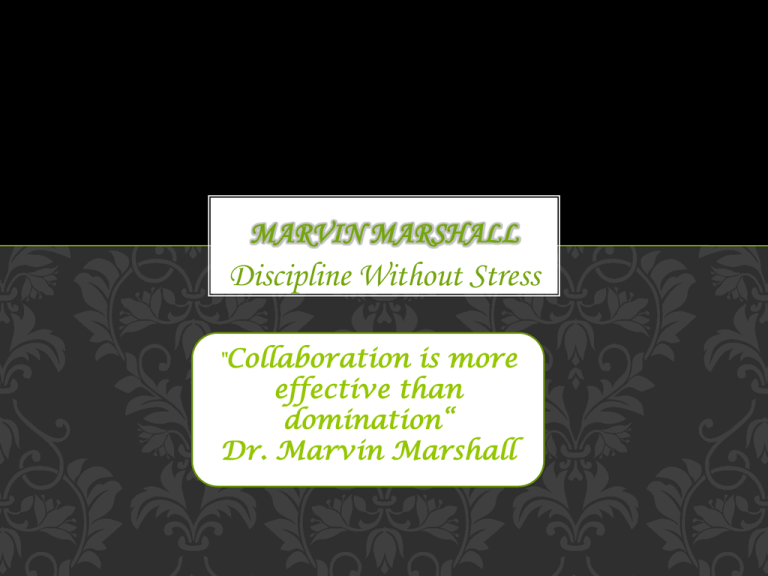
MARVIN MARSHALL Discipline Without Stress "Collaboration is more effective than domination“ Dr. Marvin Marshall MARVIN MARSHALL Marvin Marshall is a leading expert in the areas of behavior, teaching, learning, and motivation. He is the author of the landmark book Discipline without Stress® Punishments or Rewards: How Teachers and Parents Promote Responsibility & Learning. His approach is amazingly successful in reducing both misbehavior, and apathy toward learning in young people of all ages. He has been a classroom teacher at all levels in urban and suburban schools; a counselor holding certification with the William Glasser Institute; an elementary principal, middle school and high school assistant principal; and district director of education. He is a keynote speaker and has been a distinguished lecturer at state, national, and international events. He has presented in 43 of the United States and in 15 countries on five continents. His presentations are fast moving, thought provoking, humorous, and practical, and participants come away refreshed and energized and ready to try a new approach in their classrooms DISCIPLINE WITHOUT STRESS TEACHING MODEL Classroom Management vs. Discipline The key to effective classroom management is teaching and practicing procedures. This is the teacher’s responsibility. Discipline, on the other hand, has to do with behavior and is the student’s responsibility. Three Principles to Practice 1. Positivity Teachers practice changing negatives into positives. “No running” becomes “We walk in the hallways.” “Stop talking” becomes “This is quiet time.” 2. Choice Choice-response thinking is taught—as well as impulse control— so students are not victims of their own impulses. 3. Reflection Since a person can only control another person temporarily and because no one can actually change another person, asking REFLECTIVE questions is the most effective approach to actuate change in others. Raise Responsibility System (RRSystem) Asking TEACHING THE HIERARCHY The hierarchy engenders a desire to behave responsibly and a desire to put forth effort to learn. Students differentiate between internal and external motivation— and learn to rise above inappropriate peer influence. CHECKING FOR UNDERSTANDING Students reflect on their chosen LEVEL. This approach SEPARATES THE PERSON FROM THE BEHAVIOR, thereby negating the usual tendency to defend one's actions. It is often this natural tendency to self-defend that leads to confrontations. Eliciting GUIDED CHOICES If disruptions continue, a consequence or procedure is ELICITED to redirect the inappropriate behavior. This approach is in contrast to the usual coercive approach of having a consequence IMPOSED. Using the System to Increase Motivation & Learning Using the hierarchy BEFORE a lesson and reflecting AFTER a lesson increases effort and raises academic achievement. Pros What we should do as Teachers Students do good when they feel good! Not when they are being talk to in a negative way We need to communicate in a positive ways of what you want the student to do. Example: We walk in the hall. Cons What we actually do as Teachers As teachers we are known to talk to students in a negative way. Talking in a negative way does not make anyone want to listen. The brain thinks in images. When we tell students what NOT to do is what the brain “images” ex. Don’t run in the hall. Rules are necessary in games, but between people rules create adversarial relationships because they create an enforcement mentality. A more effective approach is to refer to responsibilities. Example: Responsibilities HAVE MY MATERIALS BE WHERE I BELONG FOLLOW DIRECTIONS DO MY ASSIGNMENTS BE KIND TO OTHERS Rules place the teacher in the position of the enforcer, a cop, wearing a blue uniform with copper buttons—rather than that of a teacher, coach, mentor, facilitator of learning, or educator. Enforcing rules often results in power struggles that rarely result in win-win situations or good relationships. In fact, they often result in reluctance, resistance, resentment, rebellion, and even retaliation. BENEFITS • • • • • • • • • • • • PROGRAM BENEFITS Reduces discipline referrals, class removals, and suspensions Handles classroom disruptions simply and easily Uses authority without resorting to punishment Raises individual and social responsibility Reduces the influence of peer pressure Promotes motivation for learning Integrates character education Improves school climate Enhances school safety Reduces detentions Reduces stress CLASSROOM MANAGEMENT CLASSROOM MANAGEMENT is enhanced when procedures are: 1. explained to students, 2. modeled for students, 3. practiced by students, 4. reinforced by practicing again, and periodically (when necessary) 5. practiced again. (Oftentimes practicing something one time does not put it into long-term memory.) STUDENTS AND PUNISHMENTS Punishments deprive young people of the opportunity to take responsibility for their own actions. Imposed punishment moves ownership of the problem from the student to the adult. Behavior may temporarily change at the threat of punishment—but not the way the student WANTS to behave. Punishment is temporary and transitory. Once the punishment is over, the student has “served his time” and is “free and clear” from further responsibility. Punishment, by its very nature, is counterproductive to good teaching because punishment fails to foster responsibility, cooperation, or positive motivation. TEACHERS • teachers have a responsibility to promote appropriate behavior. Promoting responsibility is more than a one time occurrence. • If a behavioral change is necessary, the stress should be on the student— not the teacher.

